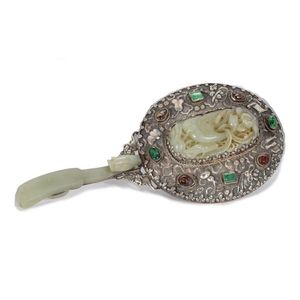Celadon Jade Mirror with Hardstone Mounting and Silver Inlay
You must be a subscriber, and be logged in to view price and dealer details.
Subscribe Now to view actual auction price for this item
When you subscribe, you have the option of setting the currency in which to display prices to $Au, $US, $NZ or Stg.
- Hardstone - Hardstone is not a scientific name for a particular gemstone, but a word used to describe any one or more semi-precious stones used in jewellery and decorative arts, and can include jade, agate, onyx, rock crystal, amber, jet and carnelian. Softer stones and minerals such as soapstone, and alabaster and hard stones used in building such as marble or granite are generally excluded.
- Qing Dynasty - The Qing Dynasty was the last imperial dynasty of China, ruling from 1644 to 1912. It was established by the Manchu people, who originated from the northeastern region of China. The Qing Dynasty was preceded by the Ming Dynasty and followed by the Republic of China.
- Ming Dynasty - The Ming Dynasty was a ruling dynasty of China from 1368 to 1644. It succeeded the Yuan Dynasty and preceded the Qing Dynasty. The Ming Dynasty was established by Zhu Yuanzhang, a former Buddhist monk who became a rebel leader and eventually overthrew the Mongol Yuan Dynasty. During the Ming Dynasty, China experienced a period of relative stability and prosperity. The government was centralized and bureaucratic, with the emperor at the top of the hierarchy. The Ming Dynasty is known for its cultural achievements, including the development of porcelain, the invention of movable type printing, and the construction of the Great Wall of China.
- Embossed / Repousse - Embossing, also known as repousse, is the technique of decorating metal with raised designs, by pressing or beating out the design from the reverse side of the object.It is the opposite of chasing, where the decoration is applied from the front. An embossed or repoussed object may have chasing applied to finish off the design.
This item has been included into following indexes:
-
Chinese jade, dressing accessories
- belt hooks 42
- hand mirrors 24
- Chinese jade, other - plaques and panels 268
Visually similar items

A pair of diamond and pearl drop earrings, each set with a central button pearl and surrounded by old cut diamonds. Diamond set line surmounts with European fittings. Total estimated weight of 26 diamonds, 3.12 carats. 18ct yellow gold and platinum. Weight

A solitaire diamond ring, centrally set with a round brilliant cut diamond weighing 1.51cts, mounted in 18ct gold, ring size J

A pale celadon jade and silver mounted mirror, the jade Qing dynasty, 19th century, the oval mirror within a silver frame inset on the reverse with an oval jade plaque carved in relief with a jardiniere of leafy plants flanked by two bats above a rockwork

An 18ct white gold diamond ring, two round brilliant cut diamonds mounted in white gold claws with a flat band, size M, weight 2.4 grams
